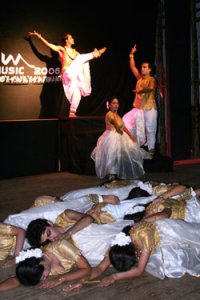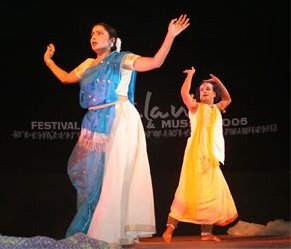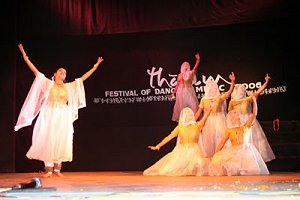
Contemporary
resonance in Kathak
- Padma Jayaraj,
Thrissur
e-mail: padmajayaraj@sancharnet.in
October 14,
2006
"Dance evolves.
We cannot put dance into watertight compartments, as modern or traditional,"
says Ashimbandhu Bhattacharjee, a well-known Kathak exponent from Kolkata.
Indeed he seems to believe in evolution as a philosophical concept. His
innovative compositions have this theme of evolution built into them. A
couple of years back, he stole the hearts and minds of the dance lovers
in Kerala with his Vasudeva. The novel theme explored the angst of Krishna
in his human incarnation. His friendship with Draupadi and its deep-rooted
bond was analyzed in the light of Vasudeva's work and philosophy on earth.
The work still remains etched in memory because of the theme - so human,
so heroic, so modern and so eternal!
 The
present trip brought three compositions onto different stages in Kerala.
Thrissur, the cultural capital of Kerala enjoyed them under the aegis of
Thalam. Fitting into the mood of Navaratri was the group item Shaktistuti
- the power of Durga in three aspects Shakti, Matri and Shanti
(the power of Strength, Universal Mother and Peace beyond understanding).
The item, a scintillating performance, pays tribute to Bengal and its cultural
legacy. By harnessing modern technology of lighting and sound, the choreography
acquires an ethereal dimension. The people of India could only worship
such strength, power and beauty. The
present trip brought three compositions onto different stages in Kerala.
Thrissur, the cultural capital of Kerala enjoyed them under the aegis of
Thalam. Fitting into the mood of Navaratri was the group item Shaktistuti
- the power of Durga in three aspects Shakti, Matri and Shanti
(the power of Strength, Universal Mother and Peace beyond understanding).
The item, a scintillating performance, pays tribute to Bengal and its cultural
legacy. By harnessing modern technology of lighting and sound, the choreography
acquires an ethereal dimension. The people of India could only worship
such strength, power and beauty.
Nabachanda
(New Rhythm), strikingly original, is a composition of nine beats. The
dancers weave various geometric patterns like, the square, oval, triangle,
parallels and their like. Designs that evoke tantric symbols and
the nuances of Rangoli, weave magic patterns to the accompaniment
of powerful, haunting music. Somewhere from the depth of consciousness,
the Srichakra emerges. The Indian mind of ancient times created the Srichakra,
which is still a mathematical challenge. As the dancers weave celestial-designs,
your spirit floats in the star-spangled sky where constellations opened
doors to astronomy and astrology in ancient India. Here the modern mind
gets connected to India's heritage, by means of costume that suits the
modern search, tastes and times. Different vocabularies of Kathak finally
merge and mingle to form an explorative symphony.
Viraha Milan
(Separation and Reunion), is highly sensuous. It portrays the pangs of
lovelorn Radha. The oft-repeated theme has a different dimension. Human
to the core, it focuses on love: an eternal ecstasy; separation its aching
partner. Here, Radha is the symbol of the human in love. She realizes love
through her memories: time spent together, joys shared together, and promises
made... alas not to be fulfilled!! She realizes her love in fantasies:
his touch, his music, his closeness. It is psychological realism that is
portrayed in such anguish. Every human being capable of love goes through
its endless pangs. The soul-mate always lives in deep isolation. In that
sense the Radha theme is timeless. The dance recital by Ashimbandhu and
his senior artist Luna Pan portrays the enduring romance from India's cultural
memories.
 Ghungroo,
(Ankle-bells) the main item, showcases the story of ankle-bells in an autobiographical
vein. An innovative piece, the group item traces the story of ankle-bells
from its birth shrouded in mystery to its role in dance performance today.
At another level, it symbolizes the classical dancer, her past, present,
and future. At a deeper level, the composition traces the evolution of
the aesthetic perception of humanity. History comes alive in different
layers: as deep as poetry, accompanied by a joy that only dance can evoke
.As the performance ends, you hear the jingling all around, deep within,
and it courses through your blood stream like the rivers of India. Ghungroo,
(Ankle-bells) the main item, showcases the story of ankle-bells in an autobiographical
vein. An innovative piece, the group item traces the story of ankle-bells
from its birth shrouded in mystery to its role in dance performance today.
At another level, it symbolizes the classical dancer, her past, present,
and future. At a deeper level, the composition traces the evolution of
the aesthetic perception of humanity. History comes alive in different
layers: as deep as poetry, accompanied by a joy that only dance can evoke
.As the performance ends, you hear the jingling all around, deep within,
and it courses through your blood stream like the rivers of India.
Nataraja is
Nature personified. The dancing Siva is nature in its innate rhythm, vigor,
harmony, and poise. The sounds and silences, the stillness between sounds,
between movements create the immanent music and rhythm of the universe.
In immemorial times the ankle bells were born during the thandava
of Nataraja; made its first jingling sounds...went to sleep...The artist
came eons later; heard the latent notes. Jingling notes tumbled down from
the murmur of the leaves on wind-driven slopes, from rushing streams, from
wafting waves, from gushing fountains, from the pitter-patter of the rains.
He heard them in the cooing of the bird and in the dance of the peacock.
Invoked by the artist, sounds rushed toward him jingling and formed itself
into a chain.
When dancing
girls wore the golden bells around their ankles, the Ghungroo found its
joy; felt ecstatic when the temple dancers danced before its Creator. Years
rolled on, the dancers became honored guests at the king's court. The Ghungroo
was proud to share the honor. Change came, history moving ahead. The Islamic
era saw a change in theme, costume, and sophistication in style. The Ghungroo
remained the signature of dancers, their alluring rhythmic steps.
 The
dark days were traumatic when dancers were exploited by male clutches.
Devadasis fell from their glory. During their days of ill repute the Ghungroo
moved stealthily when dusk deepened, or when lovers met in lonely places....The
eternal search for identity continued. In its course the Ghungroo remained
a witness to Creation, Sustenance and Destruction. Now the Ghungroo has
reached the proscenium theatre. What next? What is the future of classical
dance in India as artists struggle against onslaughts amid changing tastes?
Neither man nor woman but a divine spirit, the Ghungroo rises with hopes
and aspirations, and dreams of its lasting legacy. As long as human hearts
could be charmed by sound and stillness that create the jingling note,
the Ghungroo will live, is the message of the ballet. Indeed Ghungroo is
the signature of Indian classical dance throughout the subcontinent. Fast
pace, dramatic moments, different styles of presentation, changes in costume
and music, makes the recital an exclusive visual orchestration. The
dark days were traumatic when dancers were exploited by male clutches.
Devadasis fell from their glory. During their days of ill repute the Ghungroo
moved stealthily when dusk deepened, or when lovers met in lonely places....The
eternal search for identity continued. In its course the Ghungroo remained
a witness to Creation, Sustenance and Destruction. Now the Ghungroo has
reached the proscenium theatre. What next? What is the future of classical
dance in India as artists struggle against onslaughts amid changing tastes?
Neither man nor woman but a divine spirit, the Ghungroo rises with hopes
and aspirations, and dreams of its lasting legacy. As long as human hearts
could be charmed by sound and stillness that create the jingling note,
the Ghungroo will live, is the message of the ballet. Indeed Ghungroo is
the signature of Indian classical dance throughout the subcontinent. Fast
pace, dramatic moments, different styles of presentation, changes in costume
and music, makes the recital an exclusive visual orchestration.
Originality
marks the theme, orchestration of visual scenes, costume, lighting and
music. The story telling essence of Kathak tradition is modern in perception
to cater to our times. The dance composition incorporates movements from
Kathakali and Kalaripayattu to enhance nuances of Kathak style. Costume
is inspired by the simplicity of western ballet. Shorn of heavy ornamentation,
the dancing bodies merge with the colors of forms they represent. Lighting
is used to give broad brush strokes to cast divine dimension. Different
types of symphony, with group violin, piano beside other instruments, orchestrate
special sound effects. Recorded in the studio, the booming quality of music
with the jingling of ankle-bells dominating makes the Ghungroo piece an
experience. "Kathak is one of the most contemporary classical dance forms
that lends itself to experimentation and innovations," said Ashimbandhu
Bhattacharjee. People gathered around him in admiration for the stunning
show. "I am still a simple student of the art-form," bowed the master.
Padma
Jayaraj is a freelance journalist. She covers fine arts and travel for
The Hindu, and is a regular contributor to narthaki.com |


 The
present trip brought three compositions onto different stages in Kerala.
Thrissur, the cultural capital of Kerala enjoyed them under the aegis of
Thalam. Fitting into the mood of Navaratri was the group item Shaktistuti
- the power of Durga in three aspects Shakti, Matri and Shanti
(the power of Strength, Universal Mother and Peace beyond understanding).
The item, a scintillating performance, pays tribute to Bengal and its cultural
legacy. By harnessing modern technology of lighting and sound, the choreography
acquires an ethereal dimension. The people of India could only worship
such strength, power and beauty.
The
present trip brought three compositions onto different stages in Kerala.
Thrissur, the cultural capital of Kerala enjoyed them under the aegis of
Thalam. Fitting into the mood of Navaratri was the group item Shaktistuti
- the power of Durga in three aspects Shakti, Matri and Shanti
(the power of Strength, Universal Mother and Peace beyond understanding).
The item, a scintillating performance, pays tribute to Bengal and its cultural
legacy. By harnessing modern technology of lighting and sound, the choreography
acquires an ethereal dimension. The people of India could only worship
such strength, power and beauty.